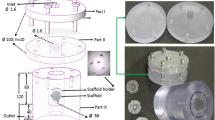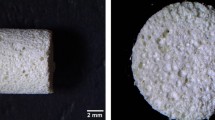Abstract
Osteoblastic cells cultured on microcarriers in bioreactors are a potentially useful tool to reproduce the in vivo three-dimensional (3D) bone network. The aim is to compare different types of 3D and two-dimensional (2D) osteoblastic culture. ROS17/2.8 cells are cultured in a bioreactor (rotating-wall vessel) or in two kinds of control (3D petri dish, 3D Percoll) and on two types of microcarrier (Cytodex 3 and Biosilon). Growth and morphology are determined by cell count and SEM, and differentiation is determined by dosage of alkaline phosphatase (ALP) activity and northern blots (ALP and osteocalcin (OC)). SEM shows that Biosilon microcarriers are the best substrate. Proliferation in the RWV and 3D petri dish is still in the exponential phase, whereas growth in the 2D culture reaches a plateau after eight days of culture. ALP activity and the ALP and OC mRNA levels are similar at day 8 for both the RWV and 3D petri dish. However, at day 10, cells are more differentiated in the RWV. The study shows that osteoblasts are both proliferate and differentiate in 3D structures. A BrDU immunocytochemical approach shows that only the cells in the periphery of the aggregates proliferate. Therefore the bioreactor may be a suitable tissue culture model for investigation of growth and differentiation processes in tissue engineering.
Similar content being viewed by others
References
Barou, O., Laroche, N., Palles, S., Alexandre, C. andLafage-Proust, M. H. (1997): ‘Preosteoblastic proliferation assessed with BrDU in undecalcified, epon-embedded adult rat trabecular bone,’J. Histochem. Cytochem.,45 (9), pp. 1–7
Becker, J. L. Prewett, T. L., Spaulding, G. F. andGoodwin, T. J. (1993): ‘Three-dimensional growth and differentiation of ovarian tumor cell line in High Aspect Rotating-Wall Vessel: Morphologic and embroyologic considerations,’J. Cell. Biochem.,51, pp. 283–289
Bellow, C. G., Aubin, J. E., Heershce, J. N. M. andAntosz, M. E. (1986): ‘Mineralized bone nodules formed in vitro from enzymatically released rat calvaria cell population,’Calcif. Tissue Int.,38, pp. 143–154
Benayahu, D., Kletter, Y., Zipori, D., andWientroub, S. (1989): ‘Bone marrow-derived stromal cell line expressing osteoblastic phenotype in-vitro and osteogenic capacity in-vivo,’J. Cell. Biol.,96, pp. 191–198
Benayahu, D., Kompier, R., Shamay, A., Kadouri, A., Zipori, D. andWientroub, S. (1994): ‘Mineralization of marrow-stromal osteoblasts MBA-15 on three-dimensional carriers,’Calcif. Tissue Int.,55, pp. 120–127
Berthod, F., Hayek, D., Damour, O. andCollombel C. (1993): ‘Collagen synthesis by fibroblasts cultures within a collagen sponge,’Biomaterials,14, (10), pp. 749–754
Bradford, M. M. (1976): ‘A rapid and sensitive method for the quantification of microgram quantities or protein utilizing the principle of protein-dye binding,’Anal. Biochem.,72, pp. 248–254
Briegle, W. (1983): ‘The clinostat, a tool for analyzing the influence of acceleration on solid-liquid systems,’ESA Symposium,206, pp. 97–101
Casser-Bette, M., Murray, A. B., Closs, E. I., Erfle, V. andSchmidt, J. (1990): ‘Bone formation by osteoblast-like cells in a three-dimensional cell culture,’Calcif. Tissue Int.,46, pp. 46–56
Cherry, R. S. andPapoutsakis, E. T. (1988): ‘Physical mechanisms of cell damage in microcarrier cell culture in cell culture bioreactors,’Biotechnol. Bioneng.,321, pp. 2002–2014
Chomczynski, P. andSacchi, N. (1987): ‘Single step method of RNA isolation by acid guanidium phenol chloroform extraction’,Anal. Bio. Chem.,162, pp. 156–159
Clark, J., Hirtenstein, M. andGeeb, C. (1980): ‘Critical parameters in the microcarrier culture of animal cells,’Dev. Biol. Standard,46, pp. 117–124
Croughan, M. S., Sayre, S. S. andWang, D. I. C. (1989): ‘Viscous reduction of turbulent damage in animal cell culture,’Biotechnol. Bioeng.,33, pp. 862–872
Donahue, H. J., McLeod, K. J., Rubin, C. T., Andersen, J., Grine, E. A., Hertzberg, E. L. andBrink, P. R. (1995): ‘Cell-to-cell communication in osteoblastic networks: cell line-dependent hormonal regulation of gap junction function,’J. Bone Miner. Res.,10, (6), pp. 881–889
Freed, L. E., Vunjak-Nopvakovic, G. andLanger, R. (1993): ‘Cultivations of cell-polymer cartilage implants in bioreactors,’J. Cell. Biochem.,51, pp. 257–264
Folkmann, J. andMoscona, A. (1978): ‘The role of cell shape in growth control,’Nature,273, pp. 345–349
Goodwin, T. J., Jessup, J. M., andWolf, D. A. (1992): ‘Morphologic differentiation of colon carcinoma cell lines HT-29 and HT-KM in Rotating-Wall Vessels,’In Vitro Cell. Dev. Biol.,28A, pp. 47–60
Goodwin, T. J., Schroeder, W. F., Wolf, D. A. andMoyer, M. P. (1993a): ‘Rotating-Wall Vessel coculture of small intestine as a prelude to tissue modeling: Aspects of simulated microgravity,’P.S.E.B.M.,202, pp. 181–192
Goodwin, T.J., Prewett, J. T., Wolf, D. A. andSpaulding, G. F. (1993b): ‘Reduced shear stress a major component on the ability of mammalian tissues to form three dimensional assemblies in simulated microgravity,’J. Cell Biochem.,51, pp. 301–311
Hoffmann, R. M. (1993): ‘To do tissue culture in two or three dimensions? That is the question,’Stem Cells Dayt.,11 (2), pp 105–111
Ingber, D. E., Prusty, D., Sun, Z., Betensky, H. andWang, N. (1995): ‘Cell shape, cytoskeletal mechanics and cell cycle control in angiogenesis,’J. Biomech.,28, pp. 1471–1484
Jessup, J. M., Brown, D., Fitzgerald, W., Nachman, F. A., Goodwin, T. J. andSpaulding, G. (1997): ‘Three-dimensional culture of bovine chondrocytes in rotating-wall vessels,’In Vitro Animal,33, (5), pp. 352–357
Klement, B. J. andSpooner, B. S. (1993): ‘Utilisation of microgravity biorectors for differentiation of mammalian skeletal tissue,’J. Cell Biochem.,51, pp. 252–256
Leighton J. (1951): ‘A sponge matrix for tissue culture. Formation of organized aggregates of cells in vitro,’J. Natl. Cancer Inst.,12, pp. 545–561
Lewis, M. L., Moriarity, D. M. andCampbell, P. S. (1993): ‘Use of microgravity for development of an in vitro rat salivary gland cell culture model,’J. Cell. Biochem.,51, pp. 265–273
Majeska, R. J., Rodan, S. B. andRodan, G. A. (1980): ‘Parathyroid hormone responsive clonal cell lines from rat osteosarcoma,’Endocrinology,107, pp. 1494–1503
Masi, L., Franchi, A., Santucchi, M., Danielli, D., Arganini, L., Giannone, V., Formigli, L., Benvenuti, S., Tanini, A., Beghe, F., Mian, M. andBrandi, L. (1992): ‘Adhesion, growth and matrix production by osteoblasts on collagen substrata,’Calcif. Tissue Int.,51, pp. 202–212
Mizuno, M., Shindo, M., Kobayashi, D., Tsuruga, E., Amemiya, A. andKuboti, Y. (1977): ‘Osteogenesis by bone stromal cells maintained on type I collagen matrix gels in vivo,’Bone,20, pp. 101–107
Prewett, T. L., Goodwin, T. J. andSpaulding, G. F. (1993): ‘Three-dimensional modeling of T-24 bladder carcinoma cell line: a new simulated microgravity culture vessel,’J. Tissue Cult. Meth.,15, pp. 29–36
Rodan, G. A. andNoda, M. (1991): ‘Gene expression in osteoblastic cells,’Crit. Rev. Eukaryotic Gene Express.,1, pp. 85–98
Rodan, G. A. andRodan, S. B. (1992): ‘The osteoblastic phenotype,’Calcium Regulat. Bone Matab.,3, pp. 183–192
Sautier, J. M., Nefussi, J. R. andForest, N. (1992): ‘Mineralization and bone formation on microcarrier beads with isolated rat calvaria cell population,’Calcif. Tissue Int.,50, pp. 527–532
Sourla, A., Doillon, C. andKoutsilieris, M. (1996): ‘Three-dimensional type I collagen gel system containing MG-63 osteoblast-like cells as a model for studying local bone reaction caused by metastatic cancer cells,’Anticancer Res.,16, pp. 2773–2780
Stein, G. S., Lian, J. B., Gerstenfeld, L. G., Shalhoub, V., Aronow, M., Owen, T. andMarkose, E. (1989): ‘The onset and progression of osteoblast differentiation is functionally related to cellular proliferation,’Connect. Tissue Res.,20, pp. 2–13
Stein, G. S. andLian, J. B. (1995): ‘Molecular mechanisms mediating proliferation-differentiation interrelationships during progressive development of the osteoblast phenotype: update 1995,’Endocr. Rev.,4, pp. 290–297
Tomson, A., Demets, R., Van Den Briel, W. andVan Den Ende, H. (1990): ‘Unicellular algae in space,’ESA Symposium,307, pp. 329–337
Tsao, Y. D., Goodwin, T. J., Wolf, D. A. andSpaulding, G. F. (1992): ‘Responses of gravity levels variations on the NASA/JSC bioreactor system,’The Physiologist,35, (1), pp. S49–50
Author information
Authors and Affiliations
Corresponding author
Rights and permissions
About this article
Cite this article
Granet, C., Laroche, N., Vico, L. et al. Rotating-wall vessels, promising bioreactors for osteoblastic cell culture: comparison with other 3D conditions. Med. Biol. Eng. Comput. 36, 513–519 (1998). https://doi.org/10.1007/BF02523224
Received:
Accepted:
Issue Date:
DOI: https://doi.org/10.1007/BF02523224




